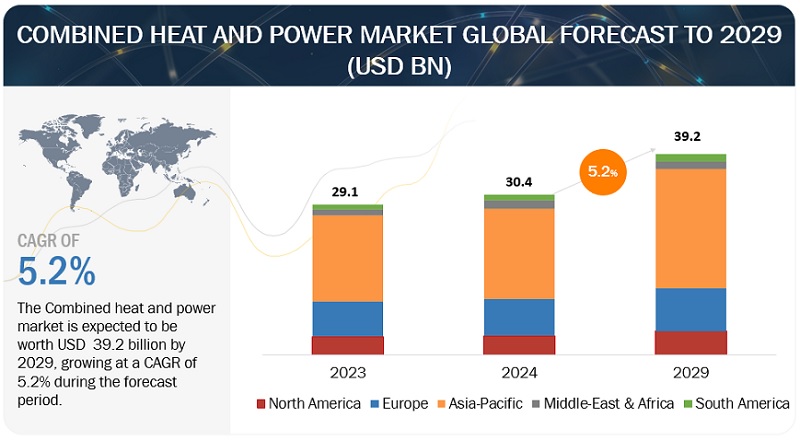According to a research report “Combined Heat and Power Market by Prime Mover (Gas Turbine, Steam Turbine, Reciprocating Engine, Fuel Cell, Microturbine), Capacity (Up to 10 MW, 10-150 MW, 151-300 MW, Above 300 MW), Fuel, End User and Region – Global Forecast to 2029″, the Combined heat and power market is projected to reach USD 39.2 billion by 2029 from an estimated USD 30.4 billion in 2024, at a CAGR of 5.2% during the forecast period.
The demand for combined heat and power (CHP) is growing due to its efficiency in generating electricity and capturing waste heat for heating or cooling purposes, reducing energy costs and emissions. It offers benefits like increased energy efficiency, lower operational costs, and enhanced grid resilience. CHP systems are used in various sectors including industrial facilities, commercial buildings, hospitals, universities, and residential complexes to meet energy needs sustainably.
Download PDF Brochure: https://www.marketsandmarkets.com/pdfdownloadNew.asp?id=26572447
Coal, by fuel, is expected to grow by the second largest segment during the forecast period.
Based on fuel, the combined heat and power market has been segmented into coal, natural gas, biogas/biomass, nuclear, diesel and others. Coal is the second-largest primary fuel source for power generation globally, contributing to about 40% of worldwide electricity production. The rise in coal-fired power plants, particularly in China and India, is driving the demand for steam turbines, thereby fueling the market for Combined Heat and Power Systems (CHPS). Due to factors such as infrastructure development projects and increased demand for electricity, coal remains a prominent choice for power generation despite concerns over coal shortages and high prices.
The utilities segment by end user is expected to grow at the second largest during the forecast period.
This report segments the combined heat and power market based on end user into utilities, industrial, commercial, and residential. The utilities segment is expected to grow as the second largest in the combined heat and power market due to its ability to offer both electricity and thermal energy at low costs. Combined Heat and Power (CHP) systems are increasingly favored by utilities. Their high efficiency, reaching up to 80%, compared to traditional thermal plants, makes them a key technology for utilities seeking to monetize heat generation and enhance operational efficiency. The rising adoption of large-scale centralized CHP systems by utilities reflects their realization of the commercial and technical benefits, driving the growth of the CHP market.

South America is expected to be the second fastest-growing region in the combined heat and power market.
South America is expected to be the second fastest-growing region in the combined heat and power market during the forecast period. The South American region has been subdivided into three key countries: Brazil, Argentina and Rest of South America. Rest of South America includes Colombia, Ecuador, Bolivia, and Chile. The combined heat and power market is flourishing in South America due to a surge in offshore exploration and oil & gas activities, coupled with significant investments required to meet rising power demands, South America emerges as the second fastest-growing region. The region’s decreasing reliance on hydroelectricity in favor of natural gas generation presents promising opportunities for the combined heat and power (CHP) market.
Ask for Sample Pages: https://www.marketsandmarkets.com/requestsampleNew.asp?id=26572447
Key Players
Some of the major players in the Combined heat and power market are GE (US), Siemens Energy (Germany), Veolia (France), Wärtsilä (Finland), and 2G Energy (Germany). The major strategies adopted by these players include sales contracts, product launches, investments, collaborations, partnerships, and expansions.


